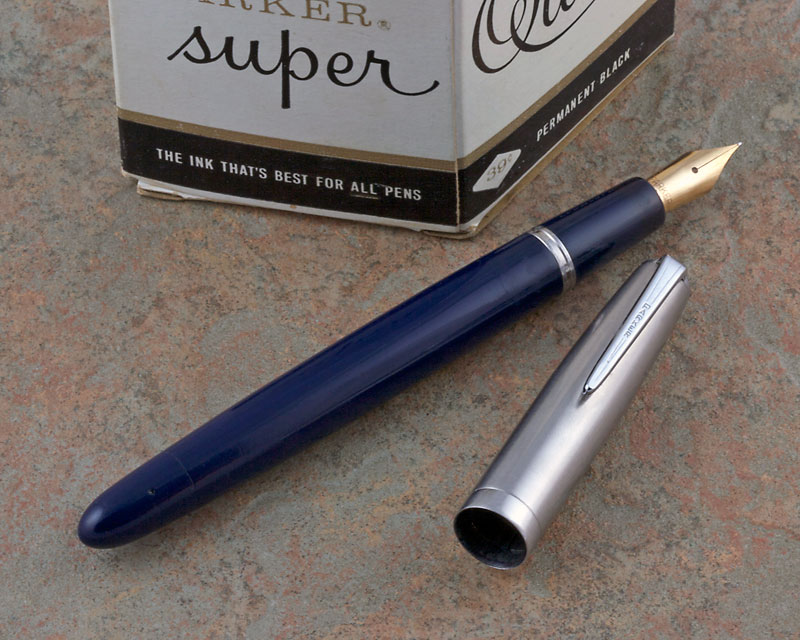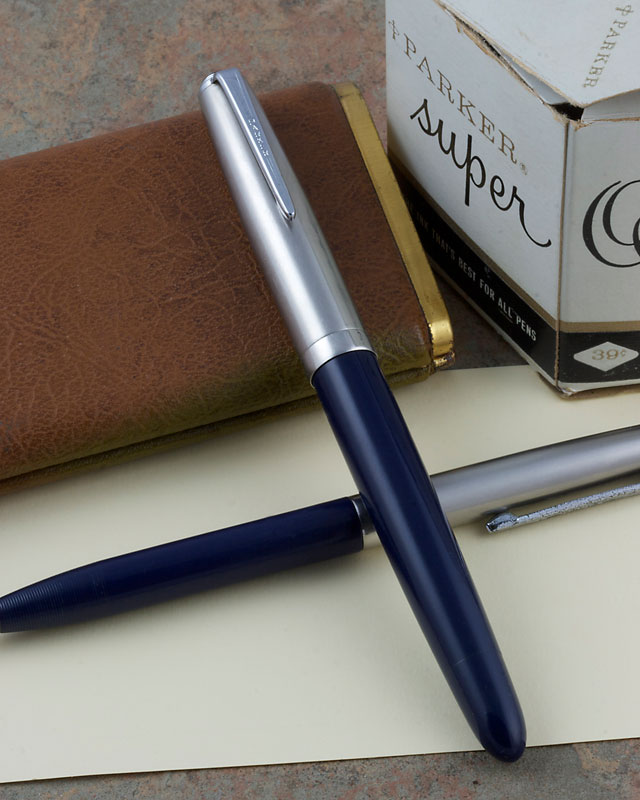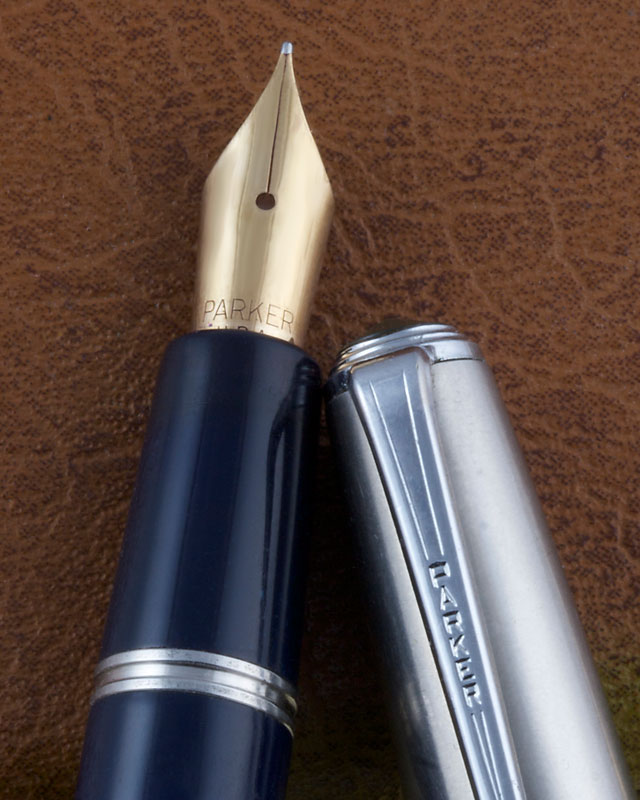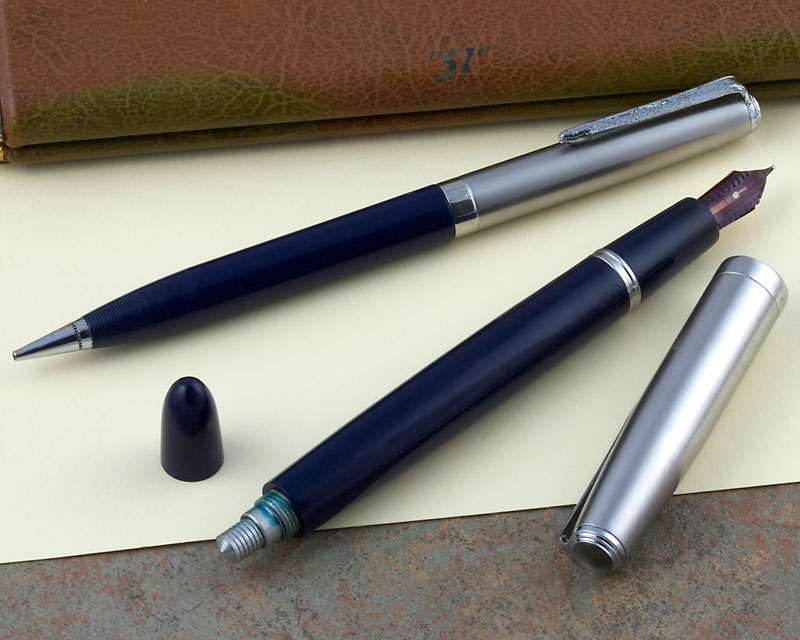PenHero 365: Parker V-S Vacumatic Successor
by Jim Mamoulides, February 10, 2010

Parker V-S Vacumatic Successor Royal Blue fountain pen open
An odd detour for Parker in 1947 was the introduction of the V-S, or "Vacumatic Successor" pen line, introduced in late 1946, according to Tony Fischier's article. The V-S, the naming convention used in the 1947 Parker Repair Manual, was one of the first pens to use the improved Parker button filling mechanism, which had a machined aluminum collar and button. The line was probably discontinued by 1949.
With the cap on, the V-S Vacumatic Successor is hardly any different in appearance from the Parker 51, save for the flat, tapered clip, which looks as if it was lifted from the bin of leftover Challenger or striped Duofold parts. The resemblance to the 51 continues with the cap removed, where from the clutch ring down to the end of the barrel, the pen resembles the 51 Vacumatic, except that at the front end, the section looks like it has been cut short and has a plain 14 karat gold open nib grafted onto the end.

Parker V-S Vacumatic Successor Royal Blue fountain pen closed with pencil
If this was intended to actually be a successor pen line to the still in production Vacumatic, one wonders why Parker slapped a generic looking nib stamped "PARKER" on the pen instead of the nicer looking Vacumatic Arrow nib. The clear feed, reportedly made from Lucite, the same material as the barrel and hood of the Parker 51, unfortunately reminds me too much of the widely advertised clear Wearever C-Flow Feed. It's doubtful that Parker would have copied any Wearever design element, and the similarity does not enhance the pen. It's certainly not a good marketing move for Parker to validate an advertised design feature from the leading cheap pen manufacturer. Parker reportedly dropped the clear feed after the first year in favor of a normal black, probably hard rubber, feed.
In addition to the aluminum button fill mechanism, the Parker V-S Vacumatic Successor has a short breather tube at the end of the feed that extends only a short distance into the ink sac in order to facilitate a more complete filling. Lastly, where the Parker 51 was made from Lucite, the same acrylic material used for airplane canopies, the V-S Vacumatic Successor was, according to the 1947 Parker Service Manual, was made from Ethyl Cellulose, a plastic used for water bottles in World War II, and these pens do not have the highly polished finish as on the 51.

Parker V-S Vacumatic Successor Royal Blue fountain pen cap and nib detail
Parker only offered four colors of the V-S Vacumatic Successor in the USA, Black, Red Brown (some collectors call this color Rust), Royal Blue and Gray. Burgundy, Brown and Green were offered in Europe. The V-S Vacumatic Successor was offered with a Lustraloy (stainless steel) cap, as shown on this example, and also with a gold-filled cap with a repeating pattern of two interrupted engraved parallel lines. The Lustraloy cap pens sold for $8.75.
The earliest example V-S Vacumatic Successor pens will have a clear feed, possibly made of Lucite, and an aluminum collar on the filler button. Later pens will have a black feed and the button collar will be cut from the end of the barrel itself, a cost saving move.

Parker V-S Vacumatic Successor Royal Blue fountain pen open with pencil, showing aluminum fill button and clear feed
This Parker V-S Vacumatic Successor is a full size, lighter weight pen, weighing 0.6 ounce and being 5 1/2 inches long with the cap on and 5 7/8 inches with the cap posted on the end of the barrel. The pen is perfectly balanced with the cap posted, as on the Parker 51, and I prefer to use it that way.
The Parker V-S Vacumatic Successor is a button filler, like earlier Parker Duofold pens. The button filling system is just as easy to use, but works slightly differently. There is a button at the base of the barrel (under the blind cap), which is pressed two times, pausing between to let the sac fill. This action bends a pressure bar inside the barrel, which squeezes the ink sac. The pen is held with one hand with the nib in the ink and the button is pressed with the thumb. As with all blind cap pens, be careful not to lose the blind cap! Wipe the nib and section and you are ready to write.
The Parker V-S Vacumatic Successor was only offered for a short time, possibly only two years, and only in limited colors and only two types of caps. They are neither especially common nor valuable, but completing a collection of them would take some focused effort. I personally find that Parker did everything they could to make this cousin of the Parker 51 as boring as possible. The nib could hardly be more plain, the clip brings nothing new to the table, the cap itself is unembellished, and the plastic barrel and section aren't even Lucite. If Parker was attempting to make sure that the V-S Vacumatic Successor did not cut into 51 sales, they did a spectacular job. What you get with this pen is a nice writer in a dull package.
Selected References
Collectible Fountain Pens, Glen Benton Bowen, Copyright © 1982, L-W Book Sales, Gas City, IN, USA
Fountain Pens of the World, Andreas Lambrou, Copyright © 1995, Zwemmer, London, England
Fountain Pens: United States and United Kingdom, Andreas Lambrou, Copyright © 2000, Phillip Wilson Publishers Ltd, London, England
Lucite, Wikipedia
Parker Service Manual No. 6643, 16th Edition, 1947, Parker Pen Company, Janesville, WI, USA
Parker Catalog, 1929, Parker Pen Company, Janesville, WI, USA
Parker "VS", Tony Fischier, © 1995-2010 Tony Fischier and The Parker Pen Company®/Sanford Ecriture
Samples of Ethyl Cellulose, Powerhouse Museum
PenHero.com Bibliography
Discuss / Recommend What You Read on PenHero.com
Follow us on Twitter: PenHero
![]()
Read about more great pens at PenHero.com
Add the photo provided above with a link to this article on your blog:
(Copy & paste code from window below)
Please only use the photo provided. Use of other photos requires permission.
Post Your Comments on this Article
Comments on this article may be sent to the author, Jim Mamoulides or posted below:
